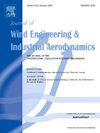Numerical investigation on the impact of aerodynamic braking plates positioned at streamlined sections on the slipstream and wake flow of the high-speed train based on train-fixed reference frame
IF 4.2
2区 工程技术
Q1 ENGINEERING, CIVIL
Journal of Wind Engineering and Industrial Aerodynamics
Pub Date : 2024-10-15
DOI:10.1016/j.jweia.2024.105920
引用次数: 0
Abstract
This paper studies the aerodynamic characteristics of high-speed trains (HSTs) featuring aerodynamic braking plates installed on the streamlined sections, employing the improved delayed detached eddy simulation (IDDES) method at Re = 5.0 × 105. The precision of the numerical simulation methodology has been validated through reduced-scale wind tunnel experiments. A comparative analysis has been conducted on the characteristics of slipstream, wake flow, and upper flow between the original configuration (OC) and the braking configuration (BC) of the HSTs. The findings reveal that the application of braking plates promotes significant separation phenomena around the HSTs, enhancing the slipstream velocity distribution. In the BC, compared to the OC, the maximum value of the time-averaged slipstream velocity has increased by approximately 134.9% and 76.8% at the trackside and platform positions, respectively. Additionally, the TSI value of the slipstream velocity shows increases of around 100.4% and 210.4% at the trackside and platform positions, respectively. Meanwhile, the turbulence fluctuations within the wake region have been enhanced, with the formation of a longitudinal vortex alongside the railway subgrade, whose core nearly covers the TSI positions. Notably, obvious shifts occur within the upper flow field, which significantly strengthens both flow turbulence and slipstream velocity, potentially influencing components on the upper surface of HSTs, such as the pantograph. The deployment of braking plates contributes to a significant increase in overall vehicle pressure drag, thereby enhancing the train's aerodynamic drag. Relative to the OC, the aerodynamic drag of the HST has increased by approximately 235.4% in the BC.
基于列车固定参照系的流线型区段空气动力制动板对高速列车滑流和尾流影响的数值研究
本文采用改进的延迟分离涡模拟(IDDES)方法,在 Re = 5.0 × 105 的条件下研究了高速列车(HST)的气动特性,该列车的流线型部分安装了气动制动板。通过缩小尺度的风洞实验验证了数值模拟方法的精确性。对 HST 原始配置(OC)和制动配置(BC)之间的滑流、尾流和上层流特性进行了对比分析。研究结果表明,制动板的应用促进了 HST 周围的显著分离现象,增强了滑流速度分布。在 BC 中,与 OC 相比,轨道边和平台位置的时间平均滑流速度最大值分别增加了约 134.9% 和 76.8%。此外,滑流速度的 TSI 值在轨道边和平台位置分别增加了约 100.4% 和 210.4%。同时,尾流区域内的湍流波动也增强了,在铁路路基旁形成了一个纵向涡流,其核心几乎覆盖了 TSI 位置。值得注意的是,上部流场发生了明显的变化,极大地增强了流动湍流和滑流速度,可能会影响 HST 上表面的部件,如受电弓。制动板的展开会显著增加整个车辆的压力阻力,从而增强列车的空气阻力。与正常运行时相比,在 BC 阶段 HST 的空气阻力增加了约 235.4%。
本文章由计算机程序翻译,如有差异,请以英文原文为准。
求助全文
约1分钟内获得全文
求助全文
来源期刊
CiteScore
8.90
自引率
22.90%
发文量
306
审稿时长
4.4 months
期刊介绍:
The objective of the journal is to provide a means for the publication and interchange of information, on an international basis, on all those aspects of wind engineering that are included in the activities of the International Association for Wind Engineering http://www.iawe.org/. These are: social and economic impact of wind effects; wind characteristics and structure, local wind environments, wind loads and structural response, diffusion, pollutant dispersion and matter transport, wind effects on building heat loss and ventilation, wind effects on transport systems, aerodynamic aspects of wind energy generation, and codification of wind effects.
Papers on these subjects describing full-scale measurements, wind-tunnel simulation studies, computational or theoretical methods are published, as well as papers dealing with the development of techniques and apparatus for wind engineering experiments.

 求助内容:
求助内容: 应助结果提醒方式:
应助结果提醒方式:


